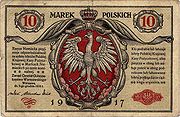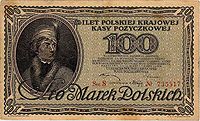
Polish marka
Encyclopedia


Kingdom of Poland (1916–1918)
The Kingdom of Poland, also informally called the Regency Kingdom of Poland , was a proposed puppet state during World War I by Germany and Austria-Hungary in 1916 after their conquest of the former Congress Poland from Russia...
and of the Republic of Poland
Second Polish Republic
The Second Polish Republic, Second Commonwealth of Poland or interwar Poland refers to Poland between the two world wars; a period in Polish history in which Poland was restored as an independent state. Officially known as the Republic of Poland or the Commonwealth of Poland , the Polish state was...
between 1917 and 1924. It was subdivided into 100 fenigow (singular fenig), much like its German
Germany
Germany , officially the Federal Republic of Germany , is a federal parliamentary republic in Europe. The country consists of 16 states while the capital and largest city is Berlin. Germany covers an area of 357,021 km2 and has a largely temperate seasonal climate...
original after which it was modelled (see German mark
German mark
The Deutsche Mark |mark]], abbreviated "DM") was the official currency of West Germany and Germany until the adoption of the euro in 2002. It is commonly called the "Deutschmark" in English but not in German. Germans often say "Mark" or "D-Mark"...
).
History
During the Great WarWorld War I
World War I , which was predominantly called the World War or the Great War from its occurrence until 1939, and the First World War or World War I thereafter, was a major war centred in Europe that began on 28 July 1914 and lasted until 11 November 1918...
, in 1915, after defeating the Russians, the Central Powers
Central Powers
The Central Powers were one of the two warring factions in World War I , composed of the German Empire, the Austro-Hungarian Empire, the Ottoman Empire, and the Kingdom of Bulgaria...
occupied the whole territory of the former Congress Poland
Congress Poland
The Kingdom of Poland , informally known as Congress Poland , created in 1815 by the Congress of Vienna, was a personal union of the Russian parcel of Poland with the Russian Empire...
and appointed two Governors General: a German (Hans Hartwig von Beseler
Hans Hartwig von Beseler
Hans Hartwig von Beseler was a German Colonel General.- Biography :Beseler was born in Greifswald, Pomerania. His father, Georg Beseler, was a law professor at the University of Greifswald. He entered the Prussian Army in 1868, fought in the Franco-Prussian War of 1870-1871, and had a successful...
) in Warsaw
Warsaw
Warsaw is the capital and largest city of Poland. It is located on the Vistula River, roughly from the Baltic Sea and from the Carpathian Mountains. Its population in 2010 was estimated at 1,716,855 residents with a greater metropolitan area of 2,631,902 residents, making Warsaw the 10th most...
and an Austro-Hungarian (Karl Kuk) in Lublin
Lublin
Lublin is the ninth largest city in Poland. It is the capital of Lublin Voivodeship with a population of 350,392 . Lublin is also the largest Polish city east of the Vistula river...
. The civil administration of the country was laid into the hands of imported German (mostly Prussia
Prussia
Prussia was a German kingdom and historic state originating out of the Duchy of Prussia and the Margraviate of Brandenburg. For centuries, the House of Hohenzollern ruled Prussia, successfully expanding its size by way of an unusually well-organized and effective army. Prussia shaped the history...
n) and Austrian (mostly Polish) officials. Four currencies circulated: the Russian ruble
Russian ruble
The ruble or rouble is the currency of the Russian Federation and the two partially recognized republics of Abkhazia and South Ossetia. Formerly, the ruble was also the currency of the Russian Empire and the Soviet Union prior to their breakups. Belarus and Transnistria also use currencies with...
, the German Papiermark
German papiermark
The name Papiermark is applied to the German currency from the 4th August 1914 when the link between the Mark and gold was abandoned, due to the outbreak of World War I...
, the German Ostruble
German ostruble
Ostruble is the name given to a currency denominated in kopeck and ruble, which was issued by Germany in 1916 for use in the eastern areas under German occupation . It was initially equal to the Russian ruble. The reason for the issue was a shortage of rubles...
and the Austro-Hungarian krone
Austro-Hungarian krone
The Krone or korona was the official currency of the Austro-Hungarian Empire from 1892 until the dissolution of the empire in 1918...
. On December 9 the following year, after consultations with the Austrians, the chief of the German Administration, Wolfgang von Kries proclaimed the foundation of a new bank, called the Polish Loan Bank (Polska Krajowa Kasa Pożyczkowa) and the creation of a new currency unit, the marka, equivalent to the German mark. The stability of the new currency was guaranteed by the German Reichsbank
Reichsbank
The Reichsbank was the central bank of Germany from 1876 until 1945. It was founded on 1 January 1876 . The Reichsbank was a privately owned central bank of Prussia, under close control by the Reich government. Its first president was Hermann von Dechend...
up to the amount of 1 billion mark.
In 1917 new coins (1, 5, 10 and 20 fenigow) and banknotes (½, 1, 2, 5, 10, 20, 50, 100, 500 and 1000 marek) were introduced and started to replace all the previously-used currencies. All the banknotes were white with the White Eagle
White Eagle
White Eagle may refer to:A coat of arms:*White Eagle of the Serbian royal houses Nemanjić, Mrnjavčević, Lazarević, Crnojević, Obrenović and Karađorđević used on the Coat of arms of Serbia and the Flag of Serbia ....
of Poland on a red field. At the time of the Armistice
Armistice
An armistice is a situation in a war where the warring parties agree to stop fighting. It is not necessarily the end of a war, but may be just a cessation of hostilities while an attempt is made to negotiate a lasting peace...
of November 11, 1918, 880 million marek were already in circulation. The new Polish government decided to retain the marka as currency and to allow the Loan Bank to continue operating. The following year the German-made banknotes were replaced in circulation with new ones. These featured Polish historical motifs. The notes of 10 and 500 marek displayed a picture of Queen Jadwiga
Jadwiga of Poland
Jadwiga was monarch of Poland from 1384 to her death. Her official title was 'king' rather than 'queen', reflecting that she was a sovereign in her own right and not merely a royal consort. She was a member of the Capetian House of Anjou, the daughter of King Louis I of Hungary and Elizabeth of...
, the notes of 5, 10, 100 and 1000 marek showed Tadeusz Kościuszko
Tadeusz Kosciuszko
Andrzej Tadeusz Bonawentura Kościuszko was a Polish–Lithuanian and American general and military leader during the Kościuszko Uprising. He is a national hero of Poland, Lithuania, the United States and Belarus...
. A silver coin of 50 marek was planned but never issued due to the galloping inflation. Only one such coin is known to exist today.
Poland, already devastated after 123 years of partitions
Partitions of Poland
The Partitions of Poland or Partitions of the Polish–Lithuanian Commonwealth took place in the second half of the 18th century and ended the existence of the Polish–Lithuanian Commonwealth, resulting in the elimination of sovereign Poland for 123 years...
and by 5 years of war, now entered a series of armed struggles, which crippled the economy even more. In 1920, during the Polish-Bolshevik War, new banknotes of ½ marki with Kosciuszko and 5000 marek with both the Queen and Kosciuszko came into use. There were now 5 billion marek in circulation. However, the following years the crisis deepened and by 1922 a period of truly ruinous inflation began. By then there were 207 billion marek in circulation. It was necessary to print notes of 10,000 and 50,000 marek. At the beginning of the following year the inflation gained even more momentum and speed, and notes of 100,000, 250,000, 500,000 and 1 million marek were introduced, only to be followed by notes of 5 and 10 million marek later that year.
Early in 1924 financial reforms of devised by politician/economist Władysław Grabski were instituted. The Bank Polski was proclaimed as the new central bank of Poland. The marka was exchanged for a new, gold-based currency, the złoty, at the rate of 1,800,000 marek to 1 złoty. One American dollar was then worth 5.18 złotych—or 9,324,000 Polish marek.
Exchange rates
Exchange rate of 1 United States dollar to Polish marka:- 1919 - 90
- 1921 - 6000
- May 1923 - 52,000
- July 1923 - 140,000
- Beginning of November 1923 - 2,000,000
- End of November 1923 - 5,000,000
- January 1924 - 9,300,000

